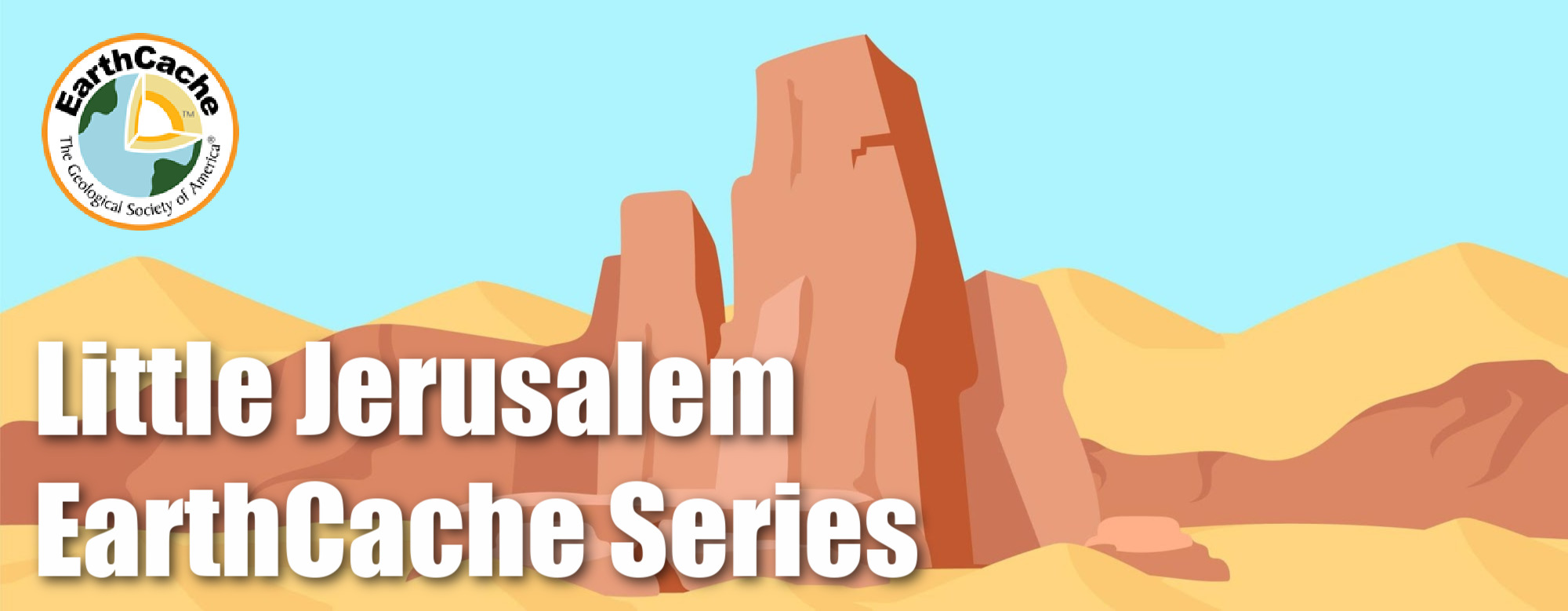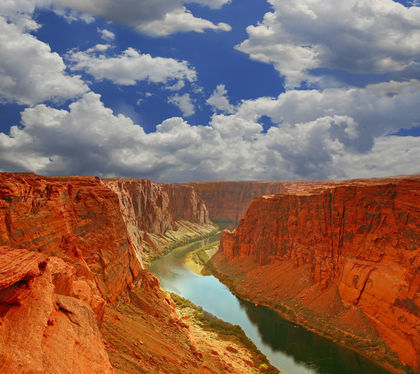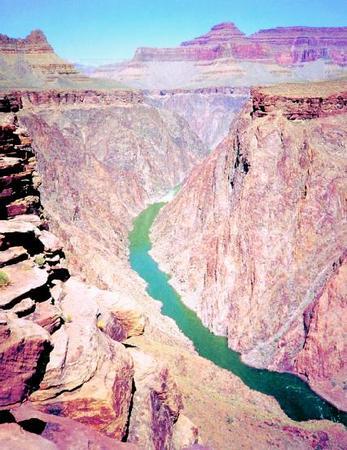
Welcome
Welcome to the Little Jerusalem EarthCache Series. This series was placed at the request of the Stae Park so it is important that you follow all rules to demonstrate how responsible geocachers are with the environment. Please stay on the trail and follow all rules as posted. At no point, should you touch, collect, or disturb the environment except where specifically directed. Please enjoy this series of EarthCaches responsibly. There is a $5 day fee to access this park.
Earth Science Lesson
At GZ, you should be standing roughly in the middle of the foot bridge. In front of you, Ignoble Canyon is visible. I bet you didn't think you would see a canyon in Kansas. Not all canyons are as large as the Gand Canyon, but this one serves a very specific purpose for our geology lesson today. It is much easier to observe what we need here than to arrange a flight over the Grand Canyon. To understand our lesosn for the day we first need to know a little about canyons.
 Canyons exist below the rim of the land, below the horizon. These ragged scars on the face of the planet descend hundreds to thousands of feet below their surrounding landscape, giving it depth. Their widths may stretch for miles or mere feet. Sunlight may fill them or may never reach their darkened bottom regions. Winding through many is water, possibly the most powerful force on the planet.
Canyons exist below the rim of the land, below the horizon. These ragged scars on the face of the planet descend hundreds to thousands of feet below their surrounding landscape, giving it depth. Their widths may stretch for miles or mere feet. Sunlight may fill them or may never reach their darkened bottom regions. Winding through many is water, possibly the most powerful force on the planet.
Sudden, tremendous events in Earth's history did not produce these landforms. Instead, it was mainly the slow, orderly process of erosion, the wearing away of the planet's surface through the action of wind and water. While wind has played a part in their formation, its effect has been subtle. The true creator of a canyon is water, primarily in the form of a river. Over millions of years, water has scoured and cut away layer upon layer of rock, lowering a canyon's floor and widening its walls. Although perhaps much more slowly, canyons created millions of years ago continue to be shaped in the present day. The erosive power of water is unrelenting.
The shape of the land
A canyon may be defined as a narrow, deep, rocky, and steep-walled valley carved by a swift-moving river. Its depth may be considerably greater than its width. Some sources use the words gorge, ravine, and chasm interchangeably with canyon. Others say they are all variations of steep-sided valleys normally with a stream or river flowing through them. A few make the distinction that canyons are usually found in arid (dry) regions characterized by plateaus, which are relatively level, large expanses of land that rise some 1,500 feet (457 meters) or more above their surroundings and have at least one steep side.
 Canyons are incredibly diverse in their forms. The walls of some canyons are V-shaped and ragged; the walls of others are steeper and almost smooth. Some canyons have been carved through sandstone and limestone and other types of sedimentary rock (rock formed by the accumulation and compression of sediment, which may consist of rock fragments, remains of microscopic organisms, and minerals). Others have been carved through multiple layers of igneous (pronounced IG-nee-us) rock, which is formed by the cooling and hardening of magma, melted rock material from within Earth, and metamorphic (pronounced meh-tah-MORE-fik) rock, whose texture or composition has been changed by extreme heat and pressure. Some canyons are dry; others are filled with rushing rivers. Some cover vast spaces; others are so narrow a person can barely squeeze through the walls.
Canyons are incredibly diverse in their forms. The walls of some canyons are V-shaped and ragged; the walls of others are steeper and almost smooth. Some canyons have been carved through sandstone and limestone and other types of sedimentary rock (rock formed by the accumulation and compression of sediment, which may consist of rock fragments, remains of microscopic organisms, and minerals). Others have been carved through multiple layers of igneous (pronounced IG-nee-us) rock, which is formed by the cooling and hardening of magma, melted rock material from within Earth, and metamorphic (pronounced meh-tah-MORE-fik) rock, whose texture or composition has been changed by extreme heat and pressure. Some canyons are dry; others are filled with rushing rivers. Some cover vast spaces; others are so narrow a person can barely squeeze through the walls.
Two main types of canyons are plateau canyons and slot canyons. The general processes responsible for their creation are uplift (the slow upward movement of large parts of stable areas of Earth's crust) and erosion. The main differences between the two types of canyons are the amount and flow of water that erodes and creates them and their relationship to their surrounding landscape.
As their name suggests, plateau canyons, such as the Grand Canyon in Arizona and the Black Canyon in Colorado, form on plateaus. They have at their floors a rushing river that continuously erodes and shapes them. If the rock forming their walls is hard and somewhat resistant to erosion, those walls may be high and steep. If their walls are made of rock that is softer and more vulnerable to erosion, those walls are likely to be less steep, V-shaped, and prone to landslides and slumps (a slump is the downward movement of blocks of material on a curved surface).
By contrast, slot canyons may be easily missed by a casual observer on a plateau. They do not open widely to the sky; their form and beauty often lie hidden beneath the ground. On the surface, the opening to a slot canyon may appear as a slash, a narrow crevice sliced through the ground. Some slot canyons measure less than 3 feet (1 meter) across at their opening. Yet beneath, from their rim to their floor, the distance may be 100 feet (30.5 meters) or more. Most often, these deep canyons are dark. At times, light from the Sun may filter down, illuminating the sculpted sandstone walls to display their palette of colors.
Slot canyons are cut and scoured by rushing water in the form of flash floods. A flash flood is a flood that occurs after a period of heavy rain, usually within six hours of the rain event. In arid environments where there is little soil to absorb the rain, water quickly runs downhill, gathering volume and speed as it goes. When it runs over the canyon, it descends in a wall of water that blasts through the canyon, eroding the walls and floor. As quickly as the water appears, it disappears, leaving the canyon dry and slightly changed until the next flood.
Logging Tasks
- Describe the walls of the canyon in front of you.
- How do you believe this canyon was formed?
- If it was formed by water in the distant past, do you believe it would have been a stream or a flash flood?
- Based on the reading above and what you observe, does this fit the definition of a plateau or slot canyon?
- Post a photo of yourself, or a proxy, at GZ. (No spoilers please)
References
- Science Clarified (2019). Canyon. Retrieved from http://www.scienceclarified.com/landforms/Basins-to-Dunes/Canyon.html
-
Antelope Canyon Navajo Tours (2020). How are slot canyons formed? Retrieved from https://navajotours.com/blog/how-are-slot-canyons-formed/
